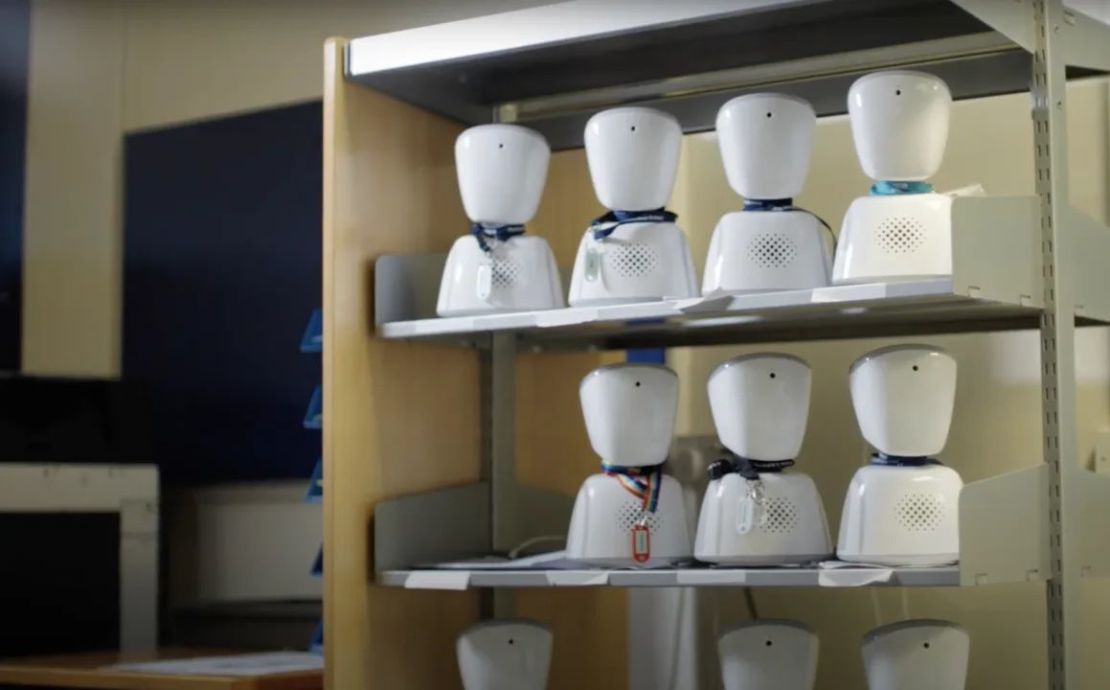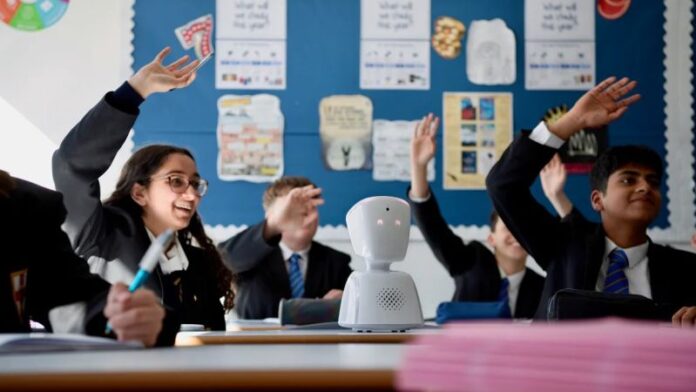(CNN) –– When children suffer from a chronic illness and cannot attend school, it is not just the condition itself that can be debilitating: the separation from the classroom and friends can also take its toll.
For young people undergoing long-term treatment or struggling with mental health issues, Norwegian company No Isolation developed the AV1 robot, which can take the child’s place in class by acting as their eyes, ears and voice. , and helps them stay connected with their classmates.
The AV1 looks like a simplified version of a human head and torso. It can rotate 360 degrees and is equipped with a camera, microphone and speaker. Teachers place it on a desk in the classroom and the student controls it remotely using an app, for which they are given a unique password.
“They can tap or swipe the screen to see different corners of the classroom,” said Florence Salisbury, marketing director for No Isolation. The student can talk to the teacher or peers through the speaker, and the app has a “raise hand” option that causes a light to flash on the robot’s head. They can also select emojis that are displayed in the robot’s eyes.
Salisbury says there are 3,000 AV1 units active in 17 countries, especially in the United Kingdom and Germany, countries where more than 1,000 robots are in operation.
In the UK, schools can rent the AV1 for around £150 (US$200) per month, or opt for a one-off purchase for £3,700 (just under US$4,960), with an additional £1 service package. 780 (around US$1,045) per year.
Salisbury says perhaps the robot’s biggest benefit is its ability to maintain social bonds. He shared the story of a 15-year-old student from Warwickshire, England, who uses AV1 and whose friends take the robot to lunch with them, keeping him included in their social circle.
“During an extended absence, where classmates may not see their friend for a long period of time, this connection to school really becomes a lifeline for that student, especially those with a medical condition,” Salisbury said. .
According to the most recent government statistics, more than 19% of students in England they were persistently absent in the autumn of 2023/24, and 7.8% of cases were due to illness. This is a figure even higher than pre-pandemic levels.
During the Covid-19 pandemic, remote learning became the norm, but when students returned to school, for many it was no longer an option. AV1 was launched before the pandemic, but some schools reported that they use robots to help students who had difficulty reintegrating into the classroom environment.
The UK’s Chartwell Cancer Trust has a supply of 25 AV1 robots that it provides to children with serious illnesses. Founding trustee Michael Douglas told CNN that the robots allow children to remain engaged in their education even while they are in intensive care. “Parents love them and they make a real difference,” she said. “They make the child important.”
But he acknowledged that there may be administrative challenges around its use and that “bureaucracy can be a real problem” when trying to introduce the AV1 system into schools or hospitals.
He added that some schools may also have difficulty maintaining the technical infrastructure necessary for smooth operation, due to WiFi or mobile signal weaknesses.

In June, research published in the journal Frontiers in Digital Healthwhich examined the use of the AV1 in Germany and the OriHime avatar robot in Japan, found that the technologies “have great potential for children to stay connected both socially and educationally.”
However, he added that structures needed to be put in place to provide equal access to avatar technologies, and that training sessions for teachers on the technical and social aspects of robots are important for successful implementation.
Last August, No Isolation launched AV1 Academy, a library of training materials and resources aimed at improving robot utilization.
According to Salisbury, the AV1 is designed with strong privacy features. No personal data is collected and the application prevents taking screenshots or recordings. Encryption protects the live stream and only one device can be connected at a time; The robot’s head and eyes light up to indicate it is in use.
There are other avatar robots on the market and some, like VGo and Buddy, have wheels and can move around the school or workplace, while others have a screen that shows the user’s face. Salisbury said not having wheels is more practical for AV1 and, weighing about 1 kilogram, the robot is easy for teachers or students to move between classes in a custom-made backpack.
Salisbury added that the absence of a screen showing the child’s face can also be an advantage. “We’ve seen that removing that pressure of being on camera increases the likelihood that the robot will be used for students who avoid school for emotional reasons,” Salisbury said.

